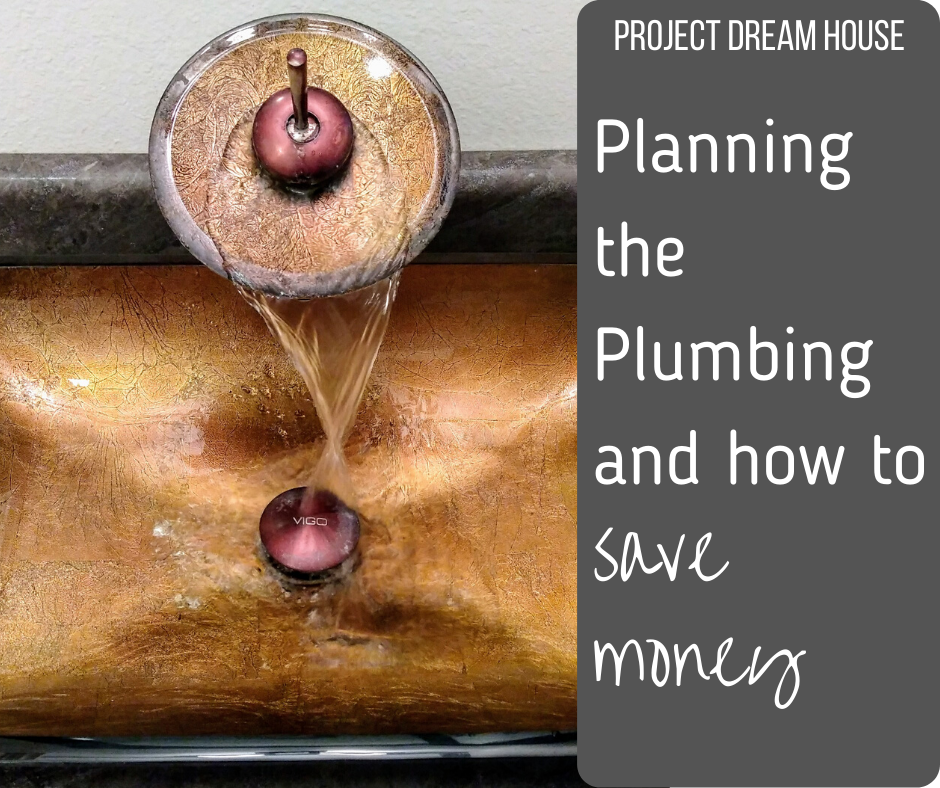When we were drawing our house plans, we put a tremendous amount of thought into how we wanted everything laid out.
We thought about traffic patterns, where the kids would play, the width of doorways, minimizing wasted space, where we were going to keep our massive book collection, etc.
One major decision to consider was where all of the plumbing was going to be located. Plumbing placement can make a huge impact on the total cost of this phase.

Kitchen Sink Placement in an Open Concept Floor Plan
The entire back of our house is an open concept with wall to wall windows. I knew I wanted the kitchen sink to be positioned so that I would be facing the rest of the family in the living room while I spent countless hours standing at the kitchen sink. (Because sometimes I feel like I LIVE in the kitchen!)
Our first house did not have an open concept so when I was in the kitchen, I was alone. House #2 was an open concept but I always had my back to the rest of the family because of where the kitchen sink was located. This was a problem I wanted to fix while drawing the plans for our Big House in the Woods.
You can fix the problem in several ways. One way would be to put the kitchen sink on an island that faces the rest of the living space. I didn’t want an island in our kitchen. I wanted to create one way into the kitchen and one way out.
Our second child was a baby at the time we were drawing our floor plans for our Big House in the Woods. The kitchen in the house we were living in at the time had two entrances and he always seemed to find a way to be underfoot. I could put a baby gate in one entrance but the other entrance was too wide. For a while, we had to create a barrier with a Christmas tree box and a chair!
The kitchen we designed for our new house is U-shaped with the sink on a pony wall facing the dining area and the living room. The one entrance to the kitchen is 3 feet wide which is perfect for a baby gate if need be.
Preventing Freezing Water Pipes in a New Construction
The second thing I wanted to fix was plumbing pipes that were located in outside walls. I know freezing temperatures aren’t a HUGE problem here in Arkansas but when the temperature drops in the winter, I start worrying about water pipes that are in outside walls.
In our new house, I wanted to make sure all of the water pipes would be located in interior walls where they would always be warm. This worked out well for the most part except for the water supply to the washing machine and the water supply to the refrigerator.
However, the water supply for the washing machine is on an exterior wall that gets all of the warm South sun in the winter. Also, it’s blocked by the north wind by the hallway that connects the house to the garage.
So, that leaves only the water supply to the refrigerator as a weak point. That’s a huge improvement from all the other houses we’ve lived in! *An important thing to note here is that even though these two water supplies are in exterior walls, they are located in heated areas. It would be much different if our laundry room was unheated.
“The pipes most at risk are those in unheated interior spaces such as basements, attics, and garages. But even pipes running through cabinets or exterior walls can freeze.”
Consumer Reports
Bathroom Placement in a New Construction
Now let’s talk about bathroom placement. The best thing you can do to keep your plumbing costs down is to keep bathrooms as close to each other as possible. For example, our half bath and our master bathroom are both on the same side of the house downstairs. This kept our materials cost down.
Also, our upstairs bathroom sits directly on top of the half bath that is downstairs. This means that our plumbing pipes can run through the same walls and we aren’t trying to run pipes to the four corners of the house.

“To save on materials and make the system more efficient, consider grouping rooms that require plumbing closer together. For instance, place a laundry room adjacent to or near the kitchen, while placing bathrooms in key locations near bedrooms. When you design rooms that have plumbing fixtures in multiple and opposite locations around the home, you can expect to pay more for materials and installation overall.”
homeguides.sfgate.com
We placed the water heater under the stairs so we wouldn’t have to waste closet space. The space under stairs is perfect for a water heater! Because of the way I designed our stairs, one side of that space is for the water heater and the other side is an awesome clubhouse for our kids. That also means that the water heater is centrally located between the kitchen sink and all the bathrooms.
Outside Faucets for a New Construction Home
The last thing we had to consider was where we wanted faucets outside. Since we were designing this house, we had the opportunity to make it fit our needs. That means we wanted water in specific places for our specific needs. (It’s all about ME ME ME!)
We put an exterior faucet on the west side of the house so we would have it near the side yard. (You can’t have “Riviera Time” without water for the pool.)
We also put a faucet on the back of the house so we would have water near the back yard and the garden I had planned.
Finally, we put a frost-free hydrant in the wooded area in front of the house so it would be near our blueberry bushes and the yard for the dogs.
After living here for a couple of years now, I am extremely happy with the way we planned everything. We put a lot of thought into every part of this house including the plumbing and it pays off every single day.
A quick note about PEX Pipe…
Plumbing with PEX Pipe
Our entire house is plumbed with PEX Pipe. Since this was the first house we had ever built, this was my first experience with PEX pipe. Ideally, I wish our house wasn’t plumbed with plastic pipe but that is what all homes are plumbed with these days. PEX has been used in the U.S. since the 80s. PEX pipe made plumbing a little easier because it doesn’t require soldering. It also made plumbing possible for DIYers. However, we are not plumbing DIYers! We hired this job to be done.
What is PEX Pipe?
You’ve probably seen it before…rolls of colorful tubing in the plumbing aisle at the hardware store. You’ll see it in red, blue, white and gray. Each color represents a different function for that particular pipe. But what is it?
“Cross-linked polyethylene (PEX), a type of flexible plastic, is currently replacing traditional copper and galvanized steel as water supply lines in both new and construction and remodeling projects.”
bobvila.com
So, PEX Pipe or PEX “tubing” is plastic tubing.
What do the different colors of PEX Pipe mean?
PEX Pipe is conveniently color-coded so plumbers and DIYers can easily know their function.
Here is what the colors mean:
Red PEX pipe: hot water
Blue PEX pipe: cold water
White PEX pipe: either hot or cold water
Gray PEX pipe: either hot or cold water
All You Need to Know About PEX Pipe from Bob Vila
Best Book for Being Your Own General Contractor
While we were building our Big House in the Woods, we frequently referenced this book:
Housebuilding: A Do-It-Yourself Guide, Revised & Expanded
I hope this answers your questions about planning the plumbing for a new construction home and PEX pipe. If you have any more questions, please leave me a comment!
Also, remember to like Big House in the Woods on Facebook so you’ll never miss a beat.
All the best,
Lindsey
*This post contains affiliate links.

Your stories prove that it can be done! Taking your time to read and investigate. It’s very impressive to me. You have never let anything get you down. ?
Thank you!
Awesome post! Keep up the great work! 🙂